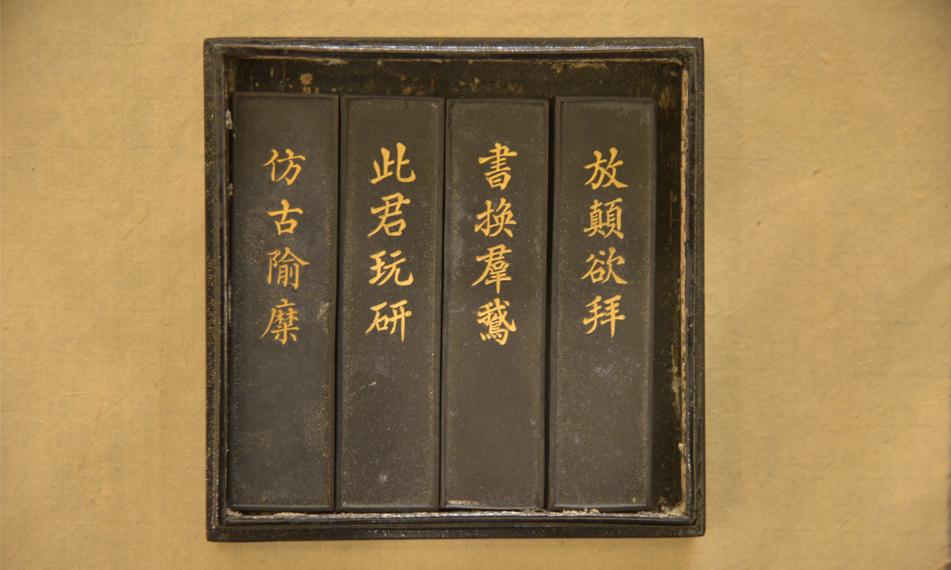Xiao Yin Literature Museum Exhibits Story 10
Xiao Yin's collection of Cao Sugong and Wang Jinsheng's "Tibetan Smoke" ancient ink (Part 2)
——Who made the ancient ink of Tibetan tobacco?
Chen Jiaji

The front of Xiao Yin's collection of "Hidden Smoke"
The back of Xiao Yin's collection of "Hidden Smoke"
The "hidden smoke" that Xiao Yin once collected on display at the Xiao Yin Literature Museum is of great value. Because they are all made by famous artists. Among them, the three ink ingots of "Let Go of Worship", "Book for Flock of Geese" and "This Jun Play Research" are Cao Su Gong system, and the "Antique Kui Mi" ink ingots are Wang Jin's holy system. The sides of these ink ingots have the words cao sugong or wang jinsheng on the side.
The three ink ingots on the side of "Let Go of Worship", "Book for Flock of Geese" and "This Jun Play Research" are "Huizhou Old Cao Su Gong System"
"Antique Kui Mi" ink ingot side words "Ancient Shewang Near Sacred Creation"
Historically, the famous ink ingot makers are Cao Sugong cao sugong, Hu Kaiwen, Wang Jie'an, and Wang Jinsheng, who are known as the four major ink makers of the Qing Dynasty.
Among the ink ingots in Xiao Yin's collection, the three ink ingots of "Wanting to Worship", "Book for Flock of Geese" and "This Jun Play Research" are Cao Su Gong system.
Cao Sugong (1615-1689), formerly known as Shengchen (聖臣), was a native of Shexian County, Anhui Province, and one of the four famous ink makers in the Qing Dynasty. In his early years, he devoted himself to the path of the eunuchs, and because he did not fulfill his wishes, he returned to his hometown to make ink as a profession. Initially borrowed the ink mold and ink name of the famous Wu Shuda, and opened a shop for business, after the ink quality and craft shape became more and more sophisticated, the reputation gradually spread, and its ink industry became more prosperous. Later moved to Suzhou, Shanghai and other places, often for the magnates and celebrities to make ink, in the upper echelons of society has a great influence, known as "the world's ink push Shezhou, Shezhou ink push Cao clan".
Among the ink ingots in Xiao Yin's collection, the "Antique Kui Mi" pictured below was made by Wang Jin.
The side words of this "antique Kui Mi" ink ingot are "Ancient Shewang Near Sacred Creation"
隃糜, pinyin yú mí, the name of the ancient county; it is famous for producing ink, and later generations borrowed finger ink or ink; by extension, it refers to Wen Mo.
Gushe is another name for Huizhou.
Wang Jinsheng (1692-1761), a famous ink maker in the Qing Dynasty. The name of the line is Yuanlin, the character Jian Gu, Huizhou Jixi people. [1] Originally an ink worker of Cao Sugong's family, he rose up during the Qing Kangxi and Yongzheng dynasties, got rid of the Cao family's shackles, and opened a "Jingu Zhai" ink shop in Huizhou Capital City alone. Its ink carving work, decoration skillful, all are not prepared for beauty, and Cao Sugong, Wang Jie'an, etc., a temporary purchase of the house salty to Wang's most.
Initially employed by Cao Sugong Ink Shop as the main table ink worker, the Qing Dynasty Yongzheng Chu (1723) County Chengcheng County opened its own "Jingu Zhai" ink shop. Its proficiency in ink theory, the unique ability to learn the ancient law, and more tuned, the ink produced, the light can be discerned, the front can be intercepted, its sound zhengzheng, black as QiHui, is regarded as the treasure of the world, the emblem belongs to the Six Yi shizi to buy its ink. In the sixth year of Qianlong (1741), the imperial court recruited ink workers in Huizhou, and Shexian ordered Zhao Ben to "appreciate the imperial court for seeing the ink of Hui, and cao clan to broadcast its name, and relied on wang Jinsheng and his son Wei Gao's production." "Therefore, I recommend Wang Weigao to enter Beijing," by being a famous author in the world. "The collection of inks produced by Wang Jinsheng is exquisite in shape, pattern and inscription, the most famous of which are: imperial four library Wenge poetry ink (5 ingots), imperial flower picture poetry ink (48 ingots), imperial cultivation and weaving picture ink (47 ingots), imperial mingyuan ink (64 ingots), Huangshan tushi ink (36 ingots), and the qianlong emperor's imperial inscription antique ink.
The four ink ingots of "Hidden Tobacco" that Xiao Yin once collected, whether they were really made by the hands of Cao Sugong and Wang Jinsheng, or the antique Tibetan cigarettes made by the descendants of the two ink makers in modern times with the ancient ink molds left by their ancestors, they are all fine products, have extremely high collection value, and also show Xiao Yin's cultural taste and artistic accomplishment from one side.